Textile Machinery
- HOME
- Our Business
- Textile Machinery
- [Parts Information] Conversion Kits: AIR JET LOOM
Parts Information Conversion Kits: AIR JET LOOM
BASIC ABILITIES
 Multi-colors
Multi-colors Shedding motion
Shedding motion Let-off
Let-off Take-up
Take-up Measuring device
Measuring device Anti-vibration base
Anti-vibration base
Multi-colors: 2C → 4C・6C・8C
Multi-colors increase fabric orders!
Quality is improved for dyed yarns, different kinds & different thicknesses with mixing effects. Combined with the dobby machine, the versatility of the ZA is dramatically widened.
2C → 4C, 6C, and 8C
* For the electronic dobby loom, weft selection (weft insertion pattern) is controlled by the electronic dobby motion.
Shedding motion: From crank shedding (plain), cam shedding to electronic dobby, electronic jacquard
Fabric orders increase by mounting the electronic dobby motion !
- Fabric construction can be easily changed with a simple operation. (Pattern setting)
- Weft selection (weft insertion pattern) is also controlled by the electronic dobby motion.
- Combined with multi-color, versatility is further increased.
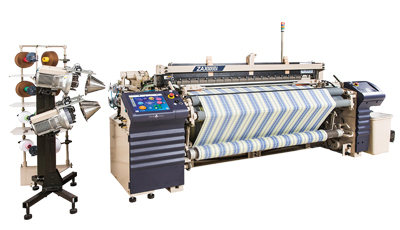
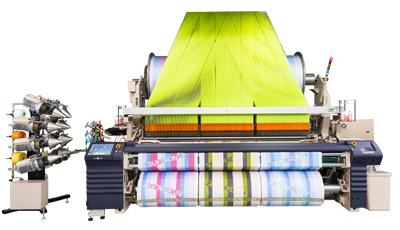
*The photo shows previous color.
Take-up device: Off-loom take-up device
Off-loom take-up device
Cloth take-up in large diameter enhances efficiency of factory operation.
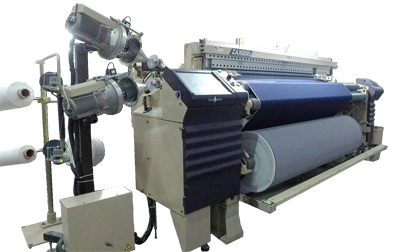
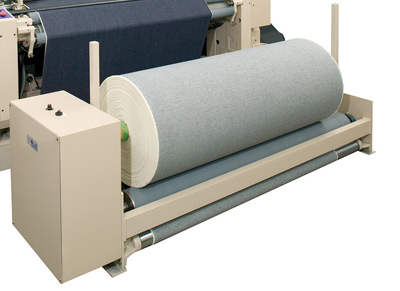
*The photo shows previous color.
AUXILIARY SPECIFICATIONS
 Weft insertion
Weft insertion Shedding motion
Shedding motion Let-off
Let-off Take-up
Take-up Selvage section
Selvage section Catch cord
Catch cord Measuring device
Measuring device Electrical components
Electrical components
Weft insertion: Stretch nozzle lateral blow type
Stretch nozzle lateral blow type improves quality!
- The lateral-blow stretch nozzle is recommended for denim, worsted, and linen-blending fabrics for which detection by the H2 feeler is important and a stretch force is required.
- It is not necessary to cut the reed to an exclusive width. The reed dents are not damaged by the pin opening.
- The standard Feeler H1 & H2 (laterally arranged) on your loom can be used as they are.
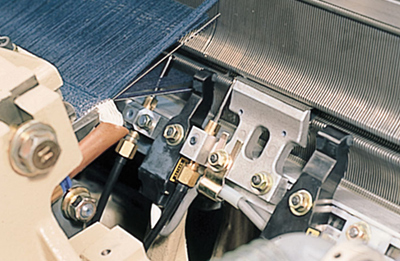
*The photo shows previous color.
Weft insertion: Main nozzle clamper
The main nozzle clamper is efficient for preventing broken picks of elastic fabrics!
- A covering yarn for a CSY (core spun yarn) can break in the nozzle while waiting even with a weak airflow.
- Because the main nozzle clamper softly clamps the weft at the inlet of the main nozzle, allowing constant jetting stoppage, breakage of the covering yarn is completely prevented. Also, the weft does not go out of the nozzle because of repulsion.
- The weft does not go out of the nozzle even when air flowing from the overhead cleaner comes through.
Especially efficient for weft pattern fabric that has a large pick number waiting time.
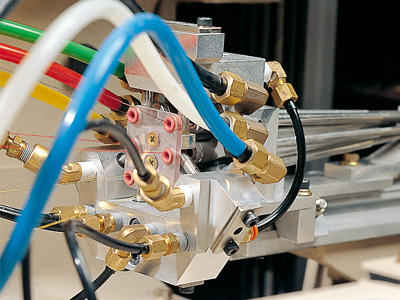
*The photo shows previous color.
Weft insertion: Multi-pick insertion
- For double-pic insertion, two wefts are inserted per 1 pick with the weft insertion device for 1 color.
- Because 2 wefts can be inserted simultaneously without increasing the color selection, productivity doubles without a great increase in costs.
- The yarn supply stand for 4 colors is used for 2 colors. Each weft passes through the package sensor, and then the two wefts per 1 color simultaneously enter into one FDP and are inserted.
- Inserting more than two wefts per one color (4 picks, 6 picks) is also available.
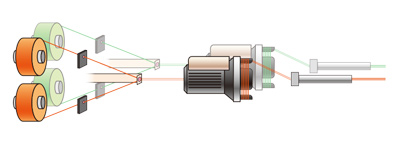
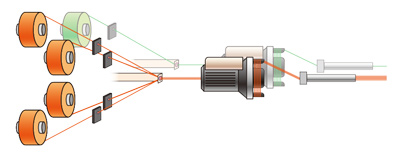
Weft insertion: Electrical cutter
The electrical cutter solves the difficulty of fine adjustment.
- The electrical cutter solves the difficulty of fine adjustment.
- The cutter timing of the main nozzle can be set on the i-board. (Easy adjustment)
- The tension in weft cutting can be adjusted according to the weft type even during operation.
- Because the cutter is inoperative during APR operation, it is unnecessary for the defective pick to escape from the cutting area. (Easy adjustment for blowing-up, increase of success ratio of the APR)
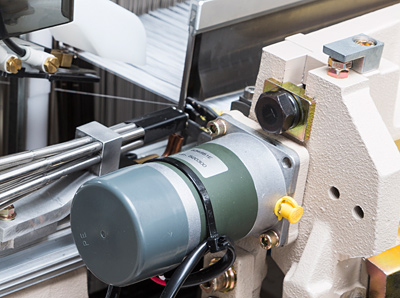
*The photo shows previous color.
Take-up: Coarse density
Coarse density fabric can be woven at higher speed.
Take-up: Bar temple
The value-added of woven cloth is increased and the productivity is improved.
- Temple marks and uneven density of woven cloth don't appear because a needle is not used.
- The straight cloth fell stabilizes the filling insertion.
- A low and even warp tension is realized.
- For 2-panel weaving, quality difference between both sides is decreased.
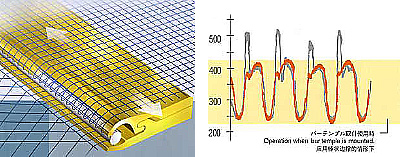
Measuring device: Balloon breaker for FDP
Stable operation with thick yarns
The balloon breaker regulates the release ballooning of thick yarns like denim, and prevents friction resistance at the nozzle inlet so that the loom can stably operate with weft insertion at low pressure.
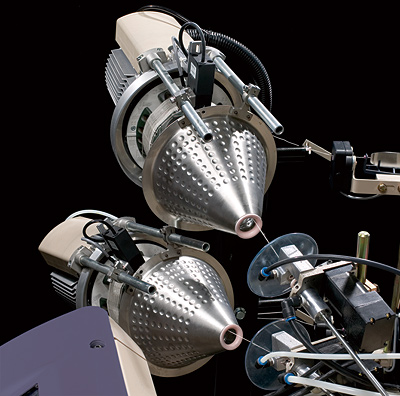
*The photo shows previous color.
Selvage section: From planetary gear system to ZT tuck-in device (With or without needles)
Value is added by changing the selvage device from the planetary gear system to the ZT, ZTN tuck-in device!
- A firm selvage without tuft is formed.
- The value of the fabric is added.
- With the intermediate ZT, ZTN tuck-in device, multi-panel weaving is possible.
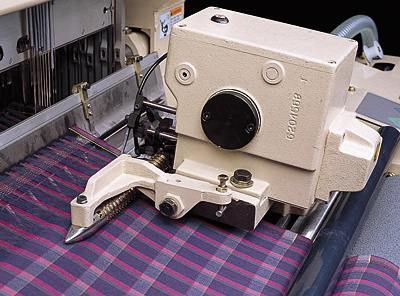
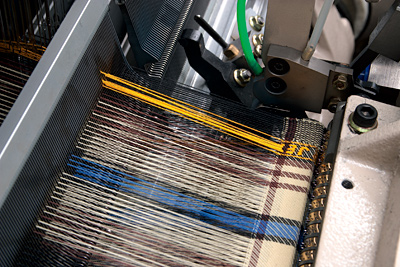
*The photo shows previous color.
Catch cord: Independent shedding motion for the catch cord (for six catch cords)
Efficient use of the heald frames
- The independent shedding motion (for six catch cords) eliminates two heald frames for catch cord.
- Because all the heald frames can be used for fabric construction, more complicated fabric styles are possible.
- It also contributes to high speed and energy savings.
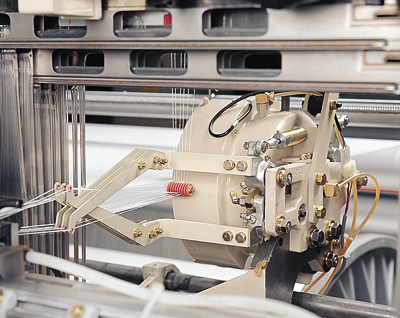
*The photo shows previous color.
Catch cord: Catch cordless (CCL)
The weft entered into the stretch nozzle is caught and held by an suction mouth and is cut by a selvage cutter for several picks.
This contributes to resource savings by eliminating the use of catch cords.
No problems about catch cords occur and operability improves.
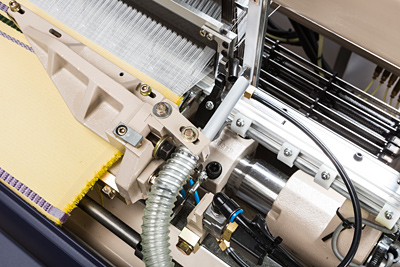
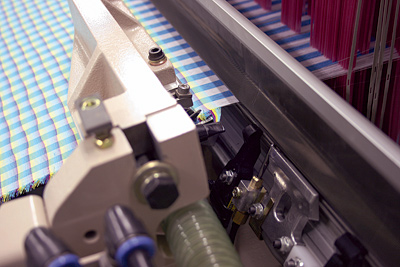
*The photo shows previous color.
Catch cord: Positive yarn catcher (PYC-II)
- The weft is caught positively at the right end of the fabric.
- The tension difference between both sides is reduced.
- It is especially useful for wefts with strong stretch.
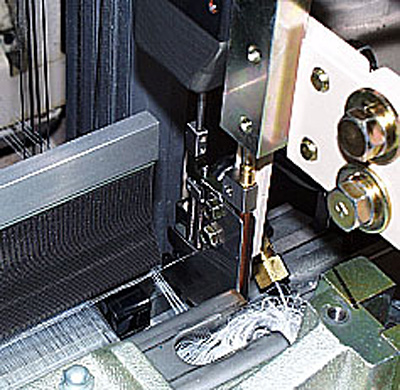
*The photo shows previous color.
Electrical components: Three-eyed feeler
Colored yarns are detected more easily.
- This feeler responds to colored yarns. Even the weft insertion combining a black dyed yarn with a white yarn is detected.
- Because it is a reflective sensor, a special reed is not required. (When a transmitted sensor is used, a special reed is required.)

Electrical components: Programmable speed control
- Independent multi-step setting of loom rpm is possible.
- Formerly the loom RPM was restricted in case of difficult weft yarns. The PSC automatically adjusts the RPM to the optimum for each yarn kind. Thus, productivity is dramatically increased. The loom RPM is changed within one pick.
- Versatility is widened by weft insertion of different kinds & thicknesses and by special weaving.
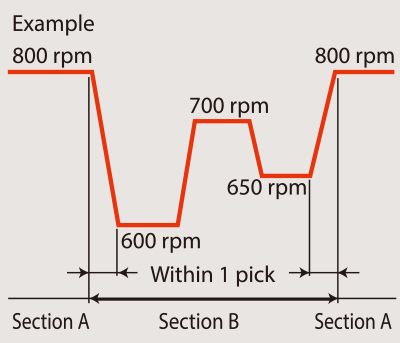
Contact Us
For catalogs, drawings, and any inquiries, contact us by contact form.